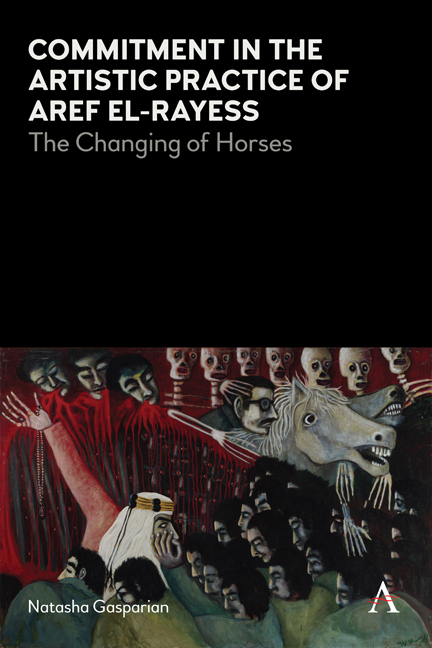3 - The Reception
Published online by Cambridge University Press: 22 February 2022
Summary
Aref El-Rayess developed an elaborate program to bring his exhibition, Blood and Freedom, to the masses. He was working according to an assertion that Sartre had underscored in his essay “For Whom Does One Write?” (1947) on the constitutive role of the reader—or in El-Rayess's case, the viewer—in the formation of the artwork. For Sartre, in this essay, the artwork has the agency to impart freedom onto the viewer who realizes its unalienating possibilities in the act of looking. El-Rayess made concerted efforts to demystify his work for a wide public. In nearly all the printed material, he referred to The Changing of Horses as The 5th of June—a title that would have been familiar to his audiences and served a commemorative function. The venue for his exhibition in the city was centrally located, and the show traveled to all the major districts of Lebanon in 1968 alone. He gave frequent tours, delivered addresses and, for the second iteration of the exhibition in Aley, provided a bullet-pointed description for each of the exhibition's 13 artworks in the catalog text. This set of descriptions—or explications, rather—solely emphasizes the works’ narrative content and makes no remarks on their formal properties or techniques. The explication of The Changing of Horses comes after the first entry on the list, herein entitled Baʿth Che Guevara, al-Falastini (The Resurrection of Che Guevara, The Palestinian) and goes as following:
The 5th of June:
The memory of the defeat.
• The skulls represent the opportunistic colonial powers who conspire against the line of national struggle.
• The Arab revolutionary is on the back of a new horse, [representing the] “will of the people.”
• The masses slap the backwardness of the palaces, as well as the brothels (mawākhīr al-layl).
• The eyes of martyrs watch from behind the curtain of death.
• Conspirers shed their blood.
El-Rayess represents The Changing of Horses as an epic tale of a revolutionary hero who follows the lead of the masses in overcoming the forces of monarchism and feudalism (the palaces and brothels to which he refers) and colonialism (the conspirers) in order to achieve national liberation. Here he presents the event of the 1967 June War as the mainspring of ongoing revolutionary struggle, rather than as a record of the defeat of the Arab forces.
- Type
- Chapter
- Information
- Commitment in the Artistic Practice of Aref El-RayessThe Changing of Horses, pp. 33 - 48Publisher: Anthem PressPrint publication year: 2020



